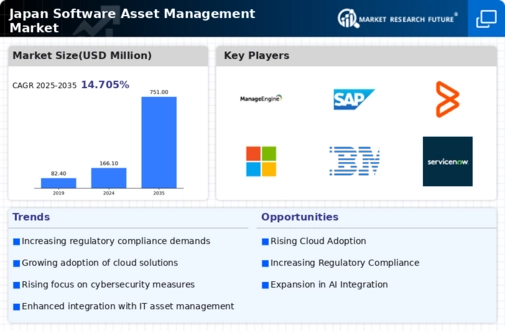Regulatory Compliance Pressures
In Japan, the software asset-management market is significantly influenced by the pressures of regulatory compliance. Organizations are compelled to adhere to various legal and industry standards, which necessitates robust software management practices. The Japanese government has implemented stringent regulations regarding software licensing and usage, leading to increased scrutiny of software assets. Companies that fail to comply may face hefty fines, which can reach up to ¥10 million. This regulatory environment drives the demand for comprehensive software asset-management solutions that ensure compliance and mitigate risks. As a result, the market is poised for growth as businesses invest in tools and processes that facilitate adherence to these regulations.
Increased Focus on Cybersecurity
The software asset-management market in Japan is increasingly influenced by the heightened focus on cybersecurity. As cyber threats become more sophisticated, organizations are prioritizing the protection of their software assets. This trend is evident in the growing investment in cybersecurity measures, with companies allocating approximately 10% of their IT budgets to software security. Effective software asset-management practices play a crucial role in identifying vulnerabilities and ensuring that software is up to date with the latest security patches. Consequently, the demand for software asset-management solutions that incorporate cybersecurity features is likely to rise, driving market growth as organizations seek to safeguard their digital assets.
Rising Demand for Cost Efficiency
The software asset-management market in Japan experiences a notable surge in demand for cost efficiency. Organizations are increasingly recognizing the financial benefits of optimizing software usage, which can lead to substantial savings. According to recent data, companies that implement effective software asset-management strategies can reduce software costs by up to 30%. This trend is particularly pronounced in sectors such as finance and manufacturing, where operational costs are closely monitored. As businesses strive to enhance their bottom line, the focus on cost-effective software solutions becomes paramount. Consequently, the software asset-management market is likely to expand as firms seek to streamline their software expenditures and maximize return on investment.
Shift Towards Remote Work Solutions
The shift towards remote work solutions is a significant driver of the software asset-management market in Japan. As more organizations adopt flexible work arrangements, the need for effective software management becomes critical. Companies are increasingly investing in software that supports remote collaboration and productivity, leading to a rise in software licenses and subscriptions. This trend is reflected in the market data, which indicates a 25% increase in demand for remote work software solutions over the past year. As businesses adapt to this new work environment, the software asset-management market is likely to expand, with a focus on managing and optimizing remote software assets.
Technological Advancements in Automation
Technological advancements in automation are reshaping the software asset-management market in Japan. The integration of artificial intelligence and machine learning into software management tools enhances efficiency and accuracy. These technologies enable organizations to automate routine tasks, such as license tracking and compliance reporting, thereby reducing the administrative burden on IT teams. As automation becomes more prevalent, companies are likely to invest in sophisticated software asset-management solutions that leverage these innovations. This shift not only improves operational efficiency but also allows organizations to focus on strategic initiatives. The market is expected to grow as businesses seek to adopt automated solutions that streamline software management processes.






















Leave a Comment